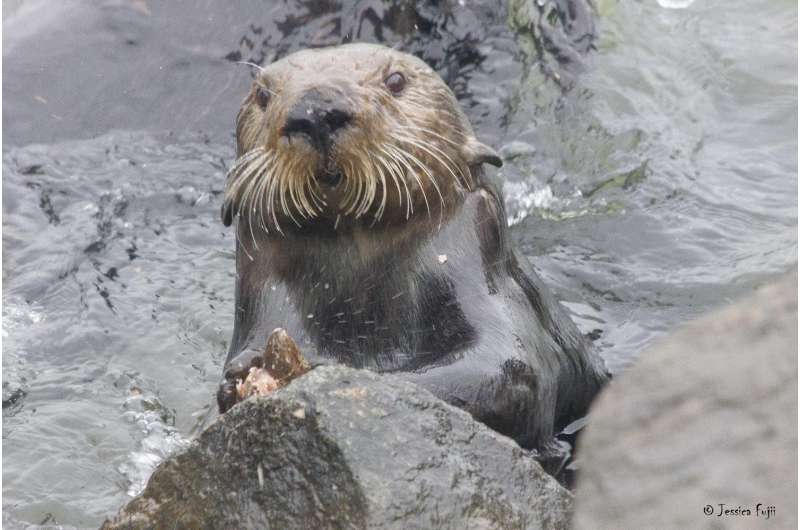Credit: © Jessica Fujii
(Phys.org)—A team of researchers affiliated with several institutions in the U.S. has found via genetic analysis that tool use by sea otters appears to go back hundreds of thousands or even millions of years. In their paper published in the journal Biology Letters, the team describes how they looked for genetic differences between groups of otters and compared their findings with tool use in bottlenose dolphins to learn more about the history of tool use in marine animals.
Tool use by land animals, particularly primates and birds, has been extensively studied, the researchers note, but little attention has been paid to tool use by marine animals. In this new effort, they looked at sea otters, which use rocks to break open shelled prey. They also studied bottlenose dolphins, which use sponges to protect their noses as they search among sharp rocks for food.
To measure how long otters have been using tools, the team conducted a genetic analysis on several specimens from multiple sites across the Pacific Ocean to determine how closely related they were to one another. They worked under the assumption that if groups of otters that used tools were more closely related to other otter tool users than to non-users, then it was likely tool use was a relatively recent development because it had not permeated to all otters everywhere. But, they found, this was not the case at all—otters that used tools were found to be no more related to other tool users than to groups that did not use tools.
When the team conducted the same type of analyses on dolphins, they found the opposite to be true. Groups that used sponges were more closely related to one another than to other groups of the same species that did not use sponges. This, the researchers contend, suggests that sea otters have been using tools for so many generations that it is now part of their basic makeup, which would take hundreds of thousands or millions of years to come about—possibly going back to the time when our human ancestors first began using tools. The bottle nosed dolphins, on the other hand, appear to be part of a group of tool users going back just a few hundred years.
More information: Mitogenomes and relatedness do not predict frequency of tool-use by sea otters, Biology Letters, rsbl.royalsocietypublishing.or … .1098/rsbl.2016.0880
Abstract
Many ecological aspects of tool-use in sea otters are similar to those in Indo-Pacific bottlenose dolphins. Within an area, most tool-using dolphins share a single mitochondrial haplotype and are more related to each other than to the population as a whole. We asked whether sea otters in California showed similar genetic patterns by sequencing mitogenomes of 43 otters and genotyping 154 otters at 38 microsatellite loci. There were six variable sites in the mitogenome that yielded three haplotypes, one found in only a single individual. The other two haplotypes contained similar percentages (33 and 36%) of frequent tool-users and a variety of diet types. Microsatellite analyses showed that snail specialists, the diet specialist group that most frequently used tools, were no more related to each other than to the population as a whole. The lack of genetic association among tool-using sea otters compared with dolphins may result from the length of time each species has been using tools. Tool-use in dolphins appears to be a relatively recent innovation (less than 200 years) but sea otters have probably been using tools for many thousands or even millions of years.
Journal information: Biology Letters
© 2017 Phys.org





















